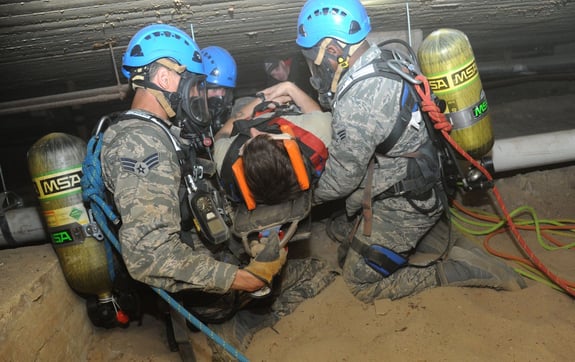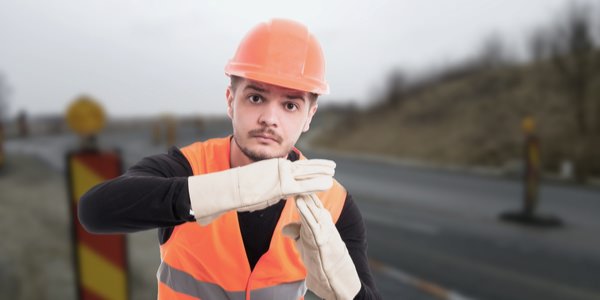
Why the hell should we care about calibrating a gas detection device?
Nothing fires up a safety guy more than hearing stories about people dying because of a stupid mistake. In 2015, 136 U.S. workers died from confined space related accidents! When someone dies because of an oversight, someone’s head is gonna roll—and it should. Listen, we all think we are rock stars at what we do, but sometimes we need a reality check.
Confined spaces in construction are everywhere. Most workers will have to enter a confined space to do work or maintenance at some point. Every worker should be able to identify a confined space and the risks that go along with them.
Identify Confined Space:
- Restricted entry or exit
- Vats
- Ditches
- Storage tanks
- Tunnels
- Silos
- Underground electrical vaults
- Inside of boilers
- Wells
- Manholes
- Trenches
- Culverts
- Cold storage

Determine if the area is a permit required confined space
- Is it a hazardous atmosphere that will require specialized PPE?
- Is there an engulfment hazard like grain?
- Could a worker be potentially trapped or asphyxiated?
- Is there a fall hazard or other serious safety risk that requires fall protection
Alright slick, if you’re shaking your head and saying to yourself, “I know this” — great! You should. Do you want to know where most people miss the boat? Sure, they make certain their crews have the right gear and have had some sort of training in the past. They even use gas detection devices and bump test them regularly to make sure their workers aren’t being sent into the pits of hell. They should be good to go. Right?
That, my friend, is a big fat no. Here’s why:

Calibration is King
While bump testing may be your knight in shining armor and your first line of defense, without calibration you have absolutely no idea if your multi-gas monitor is working. It doesn’t make a lick of sense to rely on a life-saving device if the readings are not 100% accurate every time. Calibrating gas detection devices is necessary to know you aren't getting false readings.
That's called calibration drift. Calibration drift is just a fancy way to say that a gas detection device is throwing out unreliable readings. If you aren’t 100% sure of the accuracy of your readings, what’s the point of even doing a test in the first place? If you are going to do something, do it right the first time!
Calibration systems provide an easy, automated way to make sure your gas detection devices are calibrated and working the way they should. They handle all the things you don’t have time for—from collecting information and logging important data to sending email alerts. No more guesswork when it comes to protecting lives.
“Life’s too short to be an a**hole, as an employer or as an employee” — Louis C.K.
Here are some calibration requirements you should review:
- OSHA’s 1910.146 Permit Required Confined Spaces
- ASSE Z117.1 Safety Requirements for Confined Spaces
- OSHA’s 1926 Subpart AA Confined Spaces in Construction (NEW)
1926.1203(e)(2)(iii)
Before an employee enters the space, the internal atmosphere must be tested, with a calibrated direct-reading instrument, for oxygen content, for flammable gases and vapors, and for potential toxic air contaminants, in that order. Any employee, who enters the space, or that employee's authorized representative, must be provided an opportunity to observe the pre-entry testing required by this paragraph.
Since these are performance based standards and don’t really give us too much guidance on how to actually reach those desired outcomes, NFPA 350 swoops in to save our backsides and provide a few “how-to” tips on identifying hazards, performing gas monitoring, controlling hazards and providing ventilation.
Here are a couple recommendations from NFPA:
- Use a pre-evaluation form and a checklist to identify and document hazards and record results of monitoring
- Monitor all confined spaces atmospheres and assume an area contains an atmospheric hazard until proven safe
Updated Confined Spaces Requirements in Construction
The controlling contractor must:
- Have a written confined space program
- Have a competent person identify confined or permit confined spaces
- Utilize early-warning systems that continuously monitor atmospheric and engulfment hazards like flash flooding
- Eliminate hazard or isolate hazard through lockout tagout
- Provide proper training to employees in the language that workers will understand
- Create a rescue plan for emergencies
Doing the right thing saves lives!
Conditions on a jobsite can change at any time and hazardous atmospheric conditions can develop within moments. Taking the right precautions to regularly maintain, calibrate and verify your gas detection devices are the only ways to make sure your crew is able to leave a confined space in the same condition as they went in. When you start to think about cutting corners when it comes to safety precautions, just remember what Louis C.K. said. And do the right thing.
If you need for help, just look for the HELP button on our website or right here!
Have you learned some tips for better gas monitor calibration or confined space safety? Tell us about them in the comments below!
Safety: It’s Your Life, It’s Our Business







